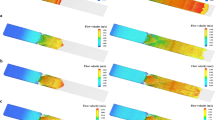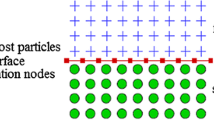Abstract
This paper presents an experimental and numerical investigation of the interaction of wet dam-break flows with a fixed structure. These flows presented breaking features and caused bow run-up and shipping water events on the deck of the structure. Wet dam-break experiments were performed using high-speed video to capture the stages of wave generation, interaction with the structure and propagation on its deck. Two different incoming flows were generated, varying the freeboard, and keeping the same wet dam-break ratio. These were numerically simulated using Moving Particle Semi-implicit (MPS) method. The purpose was to compare MPS numerical simulations based on two surface tension models previously proposed in the literature and a geometric-based surface tension model proposed in this work, this to improve free surface performance to represent breaking wave features more realistically. First, the different approaches were compared with experimental results. Then, the proposed model was implemented to analyze the effect of the velocity applied to gate opening on the water surface during wave generation, wave-bow interaction and water propagation over the deck. The distribution of particles, pressure and velocity fields was presented in this analysis. Results showed that the proposed surface tension model performed well in representing the free surface. It was seen that surface tension effects can be relevant during the wave formation effects. Furthermore, it was verified that variating the gate opening velocity, dynamic interactions of the resulting waves with the structure was affected, causing energetic processes variations. It is recommended to consider this velocity for validation purposes.
















Similar content being viewed by others
References
Greco M (2001) A two-dimensional study of green-water loading. PhD Thesis. Norwegian University of Science and Technology, Trondheim, Norway.
Greco M, Colicchio G, Faltinsen O (2007) Shipping of water on a two-dimensional structure Part 2. J Fluid Mech 581:371. https://doi.org/10.1017/S002211200700568X
Greco M, Faltinsen O, Landrini M (2005) Shipping of water on a two-dimensional structure. J Fluid Mech 525:309. https://doi.org/10.1017/S0022112004002691
Yan B, Luo M, Bai W (2019) An experimental and numerical study of plunging wave impact on a box-shape structure. Mar Struct 66:272–287. https://doi.org/10.1016/j.marstruc.2019.05.003
Zhang X, Draper S, Wolgamot H et al (2019) Eliciting features of 2D greenwater overtopping of a fixed box using modified dam break models. Appl Ocean Res 84:74–91. https://doi.org/10.1016/j.apor.2019.01.006
Buchner B (2002) Green water on ship-type offshore structures. PhD Thesis. Delft University of Technology Delft, The Netherlands. PhD Thesis, Delft University of Technology Delft, The Netherlands
Greco M, Bouscasse B, Lugni C (2012) 3-D seakeeping analysis with water on deck and slamming. Part 2: experiments and physical investigation. J Fluids Struct 33:148–179. https://doi.org/10.1016/j.jfluidstructs.2012.05.009
Silva DF, Coutinho AL, Esperança PT (2017) Green water loads on FPSOs exposed to beam and quartering seas, part I: Experimental tests. Ocean Eng 140:419–433. https://doi.org/10.1016/j.oceaneng.2017.05.005
Bradner C, Schumacher T, Cox D, Higgins C (2011) Large-scale laboratory observations of wave forces on a highway bridge superstructure. Technical Report. Oregon State University.
Lee GN, Jung KH, Malenica S et al (2020) Experimental study on flow kinematics and pressure distribution of green water on a rectangular structure. Ocean Eng 195:106649. https://doi.org/10.1016/j.oceaneng.2019.106649
Ryu Y, Chang K-A (2008) Green water void fraction due to breaking wave impinging and overtopping. Exp Fluids 45:883–898. https://doi.org/10.1007/s00348-008-0507-3
Hernández-Fontes H ID, Mendoza E, Silva R (2020) Green water evolution on a fixed structure induced by incoming wave trains. Mech Based Des Struct Mach. https://doi.org/10.1080/15397734.2020.1791179
Hernández-Fontes JV, Mendoza E, Hernández ID, Silva R (2020) A detailed description of flow-deck interaction in consecutive green water events. J Offshore Mech Arct Eng 1–17. https://doi.org/10.1115/1.4049121
Hernández-Fontes JV, Esperança PT, Silva R et al (2020) Violent water-structure interaction: overtopping features and vertical loads on a fixed structure due to broken incident flows. Mar Struct 74:102816. https://doi.org/10.1016/j.marstruc.2020.102816
Chuang W-L, Chang K-A, Mercier R (2017) Impact pressure and void fraction due to plunging breaking wave impact on a 2D TLP structure. Exp Fluids 58:68. https://doi.org/10.1007/s00348-017-2356-4
Lee N, Jung K, Park H et al (2022) Experimental study of green water on rectangular structure with varying flare angle. Ocean Eng 243:110252. https://doi.org/10.1016/j.oceaneng.2021.110252
Ryu Y, Chang K-A, Mercier R (2007) Application of dam-break flow to green water prediction. Appl Ocean Res 29:128–136. https://doi.org/10.1016/j.apor.2007.10.002
Ryu Y, Chang K-A, Lim H-J (2005) Use of bubble image velocimetry for measurement of plunging wave impinging on structure and associated greenwater. Meas Sci Technol 16:1945. https://doi.org/10.1088/0957-0233/16/10/009
Fontes JV, Hernández ID, Mendoza E et al (2021) On the evolution of different types of green water events. Water 13:1148. https://doi.org/10.3390/w13091148
Hernández-Fontes JV, Vitola MA, Silva MC et al (2018) On the generation of isolated green water events using wet dam-break. J Offshore Mech Arct Eng. DOI 10(1115/1):4040050
Nakagawa H, Nakamura S, Ichihashi K (1969) Generation and development of a hydraulic bore due to the breaking of a dam. Technical Report. Bull Disaster Prev Res Inst 19:1–17
Stansby P, Chegini A, Barnes T (1998) The initial stages of dam-break flow. J Fluid Mech 374:407–424. https://doi.org/10.1017/S0022112098009975
Hernández-Fontes JV, Vitola MA, Esperança PT et al (2020) Patterns and vertical loads in water shipping in systematic wet dam-break experiments. Ocean Eng 197:106891. https://doi.org/10.1016/j.oceaneng.2019.106891
Areu-Rangel O, Hernández-Fontes J, Silva R et al (2020) Green water loads using the wet dam-break method and SPH. Ocean Eng 108392:1–16. https://doi.org/10.1016/j.oceaneng.2020.108392
Bašić J, Degiuli N, Malenica Š, Ban D (2020) Lagrangian finite-difference method for predicting green water loadings. Ocean Eng 209:107533. https://doi.org/10.1016/j.oceaneng.2020.107533
Khojasteh D, Tavakoli S, Dashtimanesh A et al (2020) Numerical analysis of shipping water impacting a step structure. Ocean Eng 209:107517. https://doi.org/10.1016/j.oceaneng.2020.107517
Zhang X, Tian X, Guo X et al (2020) Bottom step enlarging horizontal momentum flux of dam break flow. Ocean Eng 214:107729. https://doi.org/10.1016/j.oceaneng.2020.107729
Khayyer A, Gotoh H, Tsuruta N (2014) A new surface tension model for particle methods with enhanced splash computation. J Jpn Soc Civ Eng. https://doi.org/10.2208/kaigan.70.I_26
Natsui S, Soda R, Kon T et al (2012) Wettability model considering three-phase interfacial energetics in particle method. Mater Trans 53:662–670. https://doi.org/10.2320/matertrans.M2011330
Nomura K, Koshizuka S, Oka Y, Obata H (2001) Numerical analysis of droplet breakup behavior using particle method. J Nucl Sci Technol 38:1057–1064. https://doi.org/10.1080/18811248.2001.9715136
Alam A, Kai H, Suzuki K (2007) Two-dimensional numerical simulation of water splash phenomena with and without surface tension. J Mar Sci Technol 12:59–71. https://doi.org/10.1007/s00773-006-0230-9
Zhang S, Morita K, Fukuda K, Shirakawa N (2007) A new algorithm for surface tension model in moving particle methods. Int J Numer Methods Fluids 55:225–240. https://doi.org/10.1002/fld.1448
Ichikawa H, Labrosse S (2010) Smooth particle approach for surface tension calculation in moving particle semi-implicit method. Fluid Dyn Res 42:035503. https://doi.org/10.1088/0169-5983/42/3/035503
Zhang S, Fukuda K, Morita K, Shirakawa N (2005) Simulation of the incompressible flows with the MPS method. In: The 13th international conference on nuclear engineering abstracts
Gotoh H, Sakai T (2006) Key issues in the particle method for computation of wave breaking. Coast Eng 53:171–179. https://doi.org/10.1016/j.coastaleng.2005.10.007
Xie H, Koshizuka S, Oka Y (2004) Numerical simulation of liquid drop deposition in annular-mist flow regime of boiling water reactor. J Nucl Sci Technol 41:569–578. https://doi.org/10.1080/18811248.2004.9715520
Duan G, Koshizuka S, Yamaji A et al (2018) An accurate and stable multiphase moving particle semi-implicit method based on a corrective matrix for all particle interaction models. Int J Numer Methods Eng 115:1287–1314. https://doi.org/10.1002/nme.5844
Kim KS, Kim MH (2018) Simulation of viscous and inviscid Rayleigh-Taylor instability with surface tension by using MPS. Ocean Syst Eng. 8:167–182
Gotoh H (2001) Sub-particle-scale turbulence model for the MPS method-Lagrangian flow model for hydraulic engineering. Comput Fluid Dyn Jour 9:339–347
Smagorinsky J (1963) General circulation experiments with the primitive equations: I. The basic Experiment Mon Weather Rev 91:99–164. https://doi.org/10.1175/1520-0493(1963)091%3c0099:GCEWTP%3e2.3.CO;2
Koshizuka S, Oka Y (1996) Moving-particle semi-implicit method for fragmentation of incompressible fluid. Nucl Sci Eng 123:421–434
Lee B-H, Park J-C, Kim M-H, Hwang S-C (2011) Step-by-step improvement of MPS method in simulating violent free-surface motions and impact-loads. Comput Methods Appl Mech Eng 200:1113–1125. https://doi.org/10.1016/j.cma.2010.12.001
Sanchez-Mondragon J, Vazquez-Hernandez AO (2018) Solitary wave collisions by double-dam-broken simulations with the MPS method. Eng Comput 35(1):53–70. https://doi.org/10.1108/EC-04-2016-0142
Sanchez-Mondragon J (2016) On the stabilization of unphysical pressure oscillations in MPS method simulations. Int J Numer Methods Fluids 82:471–492. https://doi.org/10.1002/fld.4227
Tanaka M, Masunaga T (2010) Stabilization and smoothing of pressure in MPS method by quasi-compressibility. J Comput Phys 229:4279–4290. https://doi.org/10.1016/j.jcp.2010.02.011
Xu T, Jin Y-C (2016) Improvements for accuracy and stability in a weakly-compressible particle method. Comput Fluids 137:1–14. https://doi.org/10.1016/j.compfluid.2016.07.014
Morris JP (2000) Simulating surface tension with smoothed particle hydrodynamics. Int J Numer Methods Fluids 33:333–353. https://doi.org/10.1002/1097-0363(20000615)33:3%3c333::AID-FLD11%3e3.0.CO;2-7
Hernández-Fontes JV, Esperança P de TT, Graniel JFB et al (2019) Green water on a fixed structure due to incident bores: guidelines and database for model validations regarding flow evolution. Water 11:2584. https://doi.org/10.3390/w11122584
Hernández-Fontes JV, Vitola MA, Paulo de Tarso TE, Sphaier SH (2019) Analytical convolution model for shipping water evolution on a fixed structure. Appl Ocean Res 82:415–429. https://doi.org/10.1016/j.apor.2018.11.005
Stoker JJ (1957) Water waves: pure and applied mathematics. Interscience Publishers New York
Lee GN, Jung KH, Chae YJ et al (2016) Experimental and numerical study of the behaviour and flow kinematics of the formation of green water on a rectangular structure. Brodogr Teor Praksa Brodogr Pomor Teh 67:133–145
Sanchez-Mondragon J, Hernández-Fontes J, Vázquez-Hernández A, Esperança P (2019) Wet dam-break simulation using the SPS-LES turbulent contribution on the WCMPS method to evaluate green water events. Comput Part Mech. https://doi.org/10.1007/s40571-019-00302-8
Acknowledgements
The author Joel Sanchez-Mondragon thanks Dirección de Cátedras CONACYT for the financial support granted during the research included in this manuscript. Jassiel V. H. Fontes thanks the support provided by “GPA/Universidade do Estado do Amazonas, Portaria Nº 086/2021-GR/UEA”. Paulo T. T. Esperança thanks the support provided by the Brazilian National Council for Scientific and Technological Development (CNPq).
Author information
Authors and Affiliations
Corresponding author
Ethics declarations
Conflicts of interest
None.
Additional information
Publisher's Note
Springer Nature remains neutral with regard to jurisdictional claims in published maps and institutional affiliations.
Appendix
Appendix
This section presents some results that demonstrate the repeatability of the experiments, which were performed five times for each study case. Figure
17a shows representative snapshots of the five repetitions, taken during the wave generation stage (at 0.28 s) for case 1. Despite the general trend of the free surface is very similar in all cases, there are small differences in the features formed by the entrapped air. Similarly, Fig. 17b shows the features of the wave-bow interaction (at 1.12 s) for the five repetitions in case 2. There are similar shapes formed by the free surface but some differences in the splash-type flow at crest and the entrapped air close to the bow edge.
Although the experiments were repeated very carefully and systematically, these small differences were noted. For systematic comparison purposes, representative cases from the five repetitions were considered in this work (see R.3 and R.2 for cases 1 and 2, respectively).
Rights and permissions
Springer Nature or its licensor (e.g. a society or other partner) holds exclusive rights to this article under a publishing agreement with the author(s) or other rightsholder(s); author self-archiving of the accepted manuscript version of this article is solely governed by the terms of such publishing agreement and applicable law.
About this article
Cite this article
Sanchez-Mondragon, J., Fontes, J.V.H., Espinoza-Haro, M.P. et al. Interaction of wet dam-break flows with a structure: on the effects of surface tension and gate opening velocity in water surface evolution using MPS method. Comp. Part. Mech. 10, 1221–1244 (2023). https://doi.org/10.1007/s40571-023-00561-6
Received:
Revised:
Accepted:
Published:
Issue Date:
DOI: https://doi.org/10.1007/s40571-023-00561-6





